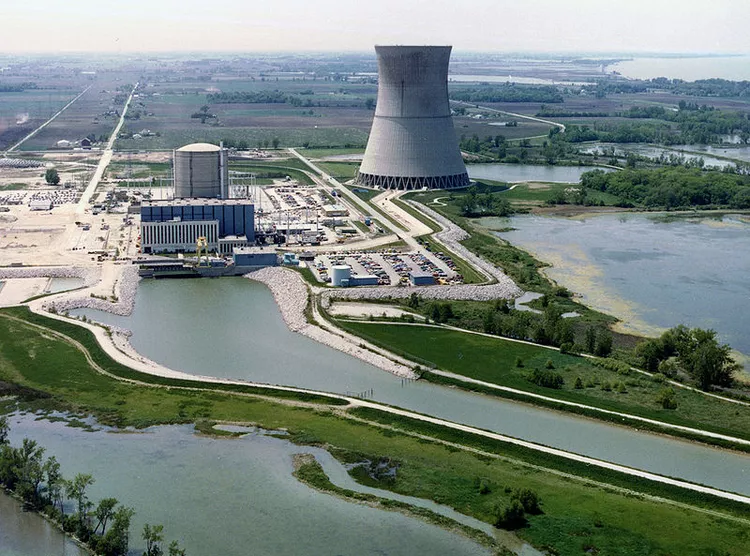What You Need to Know About the State’s 2 Power Reactors
Often referred to as a nuclear power plant, a power reactor is a facility that produces electricity via a nuclear reaction, characterized by the continuous splitting of uranium atoms. Ohio is home to two nuclear power plants situated along the shores of Lake Erie in the northern region of the state. These are the Davis-Besse plant located in Oak Harbor, near Sandusky, and the Perry Nuclear Plant, positioned east of Cleveland. (A third plant, located in Piqua, Ohio, was closed in 1966.)
A company named FirstEnergy owns both plants as well as an additional facility in Pennsylvania. Due to financial challenges, particularly competition from alternative power sources, the company will determine by 2018 whether to close or sell these power stations. FirstEnergy has engaged with the Ohio and Pennsylvania Senates to advocate for regulatory changes that would enhance their competitive stance.
Davis-Besse Nuclear Power Plant
The Davis-Besse Nuclear Power Plant is situated on a sprawling 954-acre site, approximately 10 miles north of Oak Harbor, Ohio, and just 21 miles east of Toledo. Established in 1978, it marked the first nuclear power plant in Ohio and the 57th commercial nuclear power facility in the United States. Initially co-owned by Cleveland Electric Illuminating Company and Toledo Edison, it bears the names of both companies’ chairmen, John K. Davis and Ralph M. Besse.
Davis-Besse functions as a pressurized water reactor, generating 40 percent of the electricity consumed in northwestern Ohio. Furthermore, the plant contributes over $10 million annually in local and state taxes; its operating license is set to expire in April 2037.
Notably, two-thirds of the Davis-Besse land is designated as protective wetlands named Navarre Marsh, which serve as a vital habitat for multiple American Bald Eagle nesting sites and a significant migration pathway for birds.
History of Problems at Davis-Besse

Davis-Besse has witnessed a long history of safety incidents, beginning even before its official opening:
- September 24, 1977: The plant was shut down due to troubles with the feedwater system, resulting in the pressure relief valve becoming stuck open. The NRC has since categorized this as one of the top safety incidents in the U.S.
- June 24, 1998: An F-2 tornado impacted the plant, damaging the switchyard and causing a power outage. The reactor automatically shut down until generators could restore electricity.
- March 2002: Staff discovered damage from corrosion on the steel reactor pressure vessel. The affected area was roughly the size of a football and was caused by a leak of borated water. Repair efforts took two years, and the plant incurred a fine of over $5 million from the NRC, which classified this incident as one of the top five nuclear incidents in U.S. history.
- January 2003: The facility’s private computer network became infected with the “slammer worm” virus, leading to a five-hour outage for the safety monitoring system.
- October 22, 2008: A tritium leak surfaced during an unrelated fire inspection; it was confirmed that the groundwater surrounding the plant remained free from radioactive contamination.
- March 12, 2010: During a scheduled refueling outage, inspectors identified that two nozzles on the reactor head failed to meet acceptance criteria. Subsequent inspections revealed new cracks in about one-third of the nozzles, including one posing a potential leak risk for boric acid.
- October 2011: Routine maintenance revealed a 30-foot crack in the concrete shield building surrounding the containment vessel.
- June 6, 2012: A pinhole leak was discovered in the weld of a seal while examining the reactor coolant pump.
- May 9, 2015: FirstEnergy operators announced an “unusual event” triggered by a steam leak in the turbine building.
Perry Nuclear Power Plant
The Perry Nuclear Power Plant occupies 1100 acres in North Perry, Ohio, approximately 40 miles northeast of Cleveland. Established in 1987, this facility was the 100th power reactor built in the United States.
Perry functions as a boiling water reactor and is one of the largest units of its kind in the country. Although initially constructed as a two-unit plant, it now operates with a single reactor, despite the presence of two cooling towers. The plant’s license is valid until 2026.
In 1993, the site was designated as an urban wildlife sanctuary, providing habitat for herons and a rare orchid species found in Ohio. The sanctuary also includes wetlands that support the spotted turtle, an endangered species. Fortunately, Perry has maintained a clean safety record throughout its operational history.





